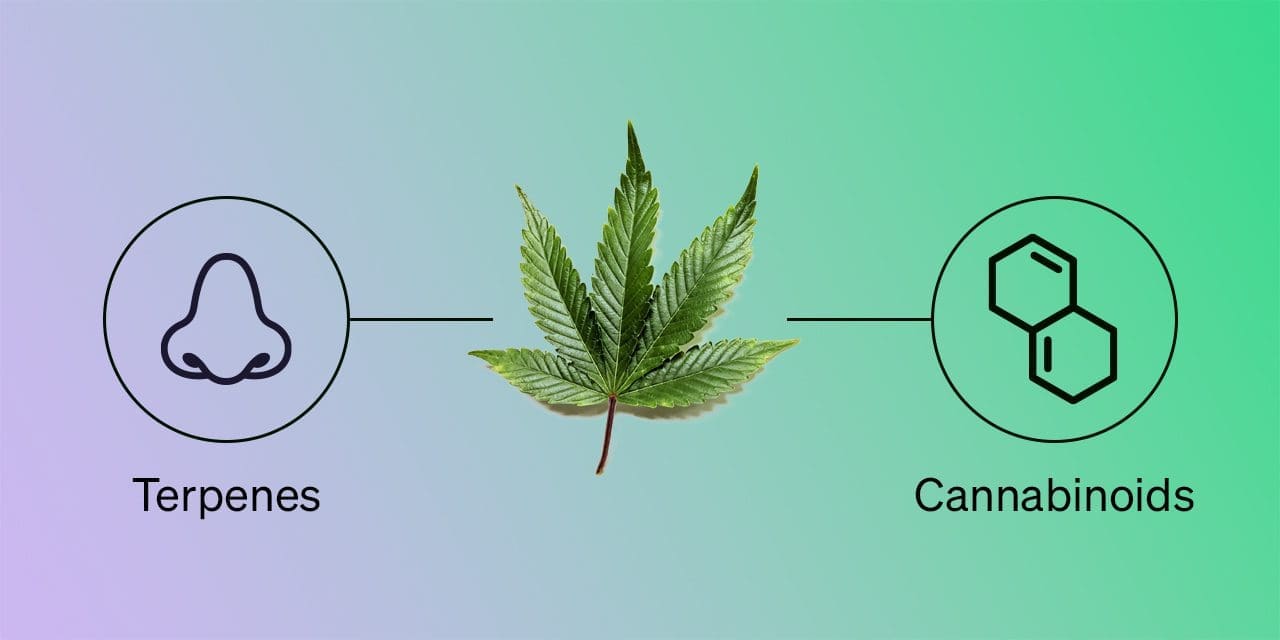What’s the difference between terpenes and terpenoids?
3 min read



Terpenes and terpenoids are two types of compounds in almost every plant, including cannabis. They add to cannabis’s flavor and aroma, and have health benefits.
Terpenes and terpenoids have a lot in common, and the biggest difference between them is that terpenoids contain oxygen, while terpenes do not. This may influence how they affect us when we consume cannabis.
Get your medical marijuana card
Connect with a licensed physician online in minutes.
Larger purchase limits Access to higher potency strains Save up to 40% on product taxes Enhanced legal protection
What are terpenes?
Terpenes are compounds made of carbon and hydrogen atoms, and they exist in every plant species. They affect a plant’s smell and taste, attract pollinators, and have properties that protect plants against diseases and infestations.
There are over 20,000 terpenes in nature, and at least 150 terpenes in cannabis. Each cannabis strain has a unique terpene profile, which is why every strain tastes, smells, and affects us differently.
Researchers are exploring how terpenes can benefit our health. Some studies have found that terpenes may enhance the pain-relieving effects of cannabis’s cannabinoids, including tetrahydrocannabinol (THC) and cannabidiol (CBD).
Commonly known terpenes
Some terpenes are more prominent in cannabis than others.
Beta-caryophyllene
Also found in black pepper and hops, beta-caryophyllene brings a spicy note to cannabis. It has anti-anxiety and anti-inflammatory effects, and may reduce brain inflammation related to Alzheimer’s disease.
Eucalyptol
Eucalyptol is the main terpene in eucalyptus, and has a strong minty aroma. It may open up the airways, reduce inflammation, and improve focus. Some studies show that eucalyptol could help fight skin cancer.
Limonene
Limonene makes some cannabis strains taste like citrus. It’s an antioxidant, and anecdotally, many users report that high-limonene strains improve their mood and energy levels.
Linalool
Linalool is also found in lavender and cilantro. According to studies, it may help with the symptoms of stroke, Alzheimer’s disease, inflammation, and neuropathic pain. Linalool may also improve conditions like depression, anxiety, and insomnia.
Myrcene
Myrcene is a very common cannabis terpene that may help with anxiety and insomnia. Besides cannabis, it’s found in many fruits, and has a sweet and spicy flavor.
Pinene
Pinene adds a pine-like scent and flavor to cannabis. It’s an antioxidant and anti-inflammatory that’s being explored for anticancer properties.
What are terpenoids?
Terpenoids are terpenes that have become oxygenated (combined with oxygen). Like terpenes, they contribute to the smell, flavor, and potential benefits of cannabis. Like terpenes, terpenoids exist in all plant species.
It’s unclear how terpenoids interact with your body compared to terpenes. It’s also unknown whether terpenoids, like terpenes, can enhance certain effects of cannabinoids.
Terpenoids are believed to have health benefits, although more studies are needed. Because terpenoids contain a hydrogen atom, it’s possible that they affect the body differently from terpenes.
Commonly known terpenoids
Some terpenoids are more common in cannabis than others, including:
- Cubebol
- Humulene epoxide
- Linalool oxide
- Nerolidol
- Sabinene hydrate
The individual effects of these terpenoids is largely unknown, with the exception of nerolidol. According to animal studies, nerolidol may have:
In summary: Terpenes and terpenoids both play important roles in cannabis
Both terpenes and terpenoids improve our cannabis experience, whether by enhancing the smell and taste of each strain, or by benefiting our health. However, more research is needed to fully understand their effects.
To explore their potential benefits for yourself, consider a medical cannabis card that gives you access to high-quality cannabis products. Leafwell’s healthcare providers can guide you through the application process and help you choose strains that best suit your needs.
Resources
- Alpha pinene modulates UVA-induced oxidative stress, DNA damage and apoptosis in human skin epidermal keratinocytes. https://pubmed.ncbi.nlm.nih.gov/30292828/
- Anti-cancer potential of cannabinoids, terpenes, and flavonoids present in cannabis. https://www.mdpi.com/2072-6694/12/7/1985
- Antioxidant activity of limonene on normal murine lymphocytes: relation to H2O2 modulation and cell proliferation. https://pubmed.ncbi.nlm.nih.gov/19796276/
- Anti-tumor effect of α-pinene on human hepatoma cell lines through inducing G2/M cell cycle arrest. https://pubmed.ncbi.nlm.nih.gov/25837931/
- A review of the potential use of pinene and linalool as terpene-based medicines for brain health: Discovering novel therapeutics in the flavours and fragrances of cannabis. https://www.frontiersin.org/journals/psychiatry/articles/10.3389/fpsyt.2021.583211/full
- β-Caryophyllene ameliorates the Alzheimer-like phenotype in APP/PS1 Mice through CB2 receptor activation and the PPARγ pathway. https://pubmed.ncbi.nlm.nih.gov/25171128/
- Beta-caryophyllene as an antioxidant, anti-inflammatory and re-epithelialization activities in a rat skin wound excision model. https://pmc.ncbi.nlm.nih.gov/articles/PMC10970213/
- Comparative anti-infectious bronchitis virus (IBV) activity of (-)-pinene: Effect on nucleocapsid (N) protein. https://pubmed.ncbi.nlm.nih.gov/21350392/
- Eucalyptol and its role in chronic diseases. https://pubmed.ncbi.nlm.nih.gov/27771935/
- Eucalyptol targets PI3K/Akt/mTOR pathway to inhibit skin cancer metastasis. https://pubmed.ncbi.nlm.nih.gov/35165685/
- Linalool as a therapeutic and medicinal tool in depression treatment: A review. https://pmc.ncbi.nlm.nih.gov/articles/PMC9886818/
- Myrcene—What are the potential health benefits of this flavouring and aroma agent? https://pmc.ncbi.nlm.nih.gov/articles/PMC8326332/
- Nerolidol attenuates oxidative stress, inflammation, and apoptosis by modulating Nrf2/MAPK signaling pathways in doxorubicin-induced acute cardiotoxicity in rats. https://pmc.ncbi.nlm.nih.gov/articles/PMC8235529/
- Secondary terpenes in Cannabis sativa L.: Synthesis and synergy. https://pmc.ncbi.nlm.nih.gov/articles/PMC9775512/
- Studies show cannabis terpenes may relieve chemotherapy-induced neuropathic pain. https://healthsciences.arizona.edu/news/releases/study-shows-cannabis-terpenes-may-relieve-chemotherapy-induced-neuropathic-pain
- Study shows cannabis terpenes provide pain relief, contribute to ‘entourage effect’. https://www.sciencedaily.com/releases/2021/07/210714110455.htm
- Terpenes in Cannabis sativa – From plant genome to humans. https://www.sciencedirect.com/science/article/pii/S0168945219301190
- Terpenes/terpenoids in Cannabis: Are they important? https://karger.com/mca/article/3/1/25/188913/Terpenes-Terpenoids-in-Cannabis-Are-They-Important
- The “entourage effect”: Terpenes coupled with cannabinoids for the treatment of mood disorders and anxiety disorders. https://pmc.ncbi.nlm.nih.gov/articles/PMC7324885/
Get Your Medical Marijuana Card
Connect with a licensed physician online in minutes.
Larger purchase limits Access to higher potency strains Save up to 40% on product taxes Enhanced legal protection
Frequently asked questions
Find answers to FAQs about terpenes and terpenoids.


